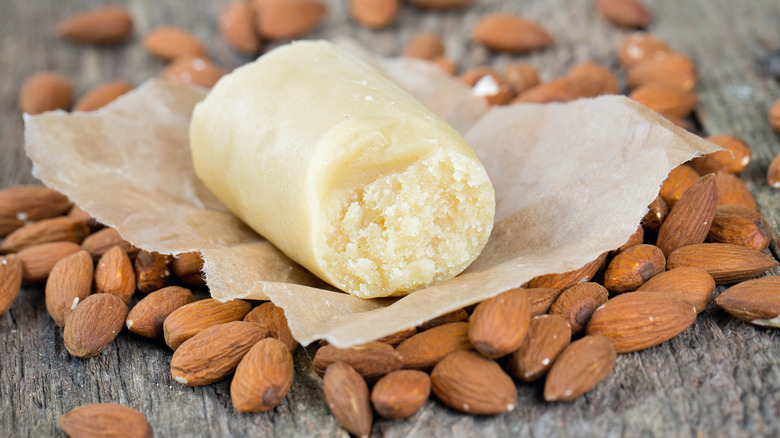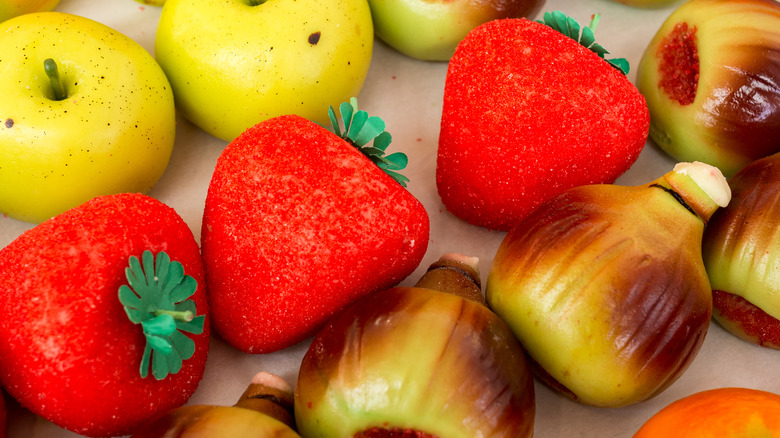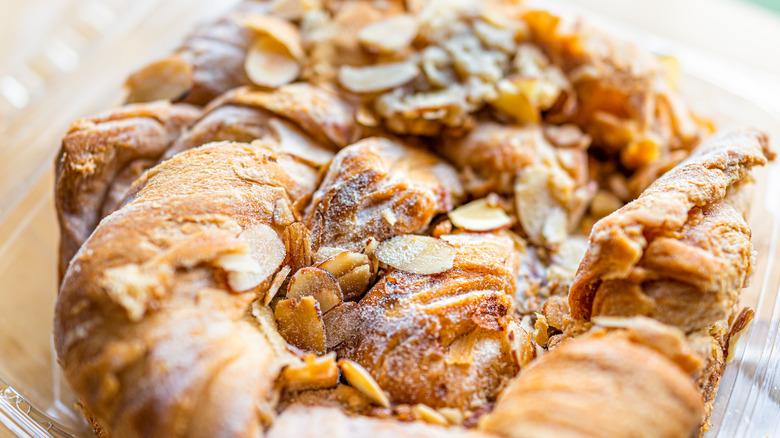Almond Paste And Marzipan Actually Aren't The Same At All
Almonds are everywhere. It wasn't long ago that almond milk was a novelty. Now, there are so many that we need to rank the brands. Before almond milk, however, there were plenty of ways to add some nuttiness to dishes.
Centuries ago, cooks started pureeing almonds with sugar to make almond paste and marzipan. These add a nutty sweetness to all sorts of baked goods and are seemingly identical. But, while closely related, these culinary cousins have vastly different jobs.
Almond paste, in its simplest form, is almonds and sugar ground into, well, a paste. It will often include a bit of egg white to help bind the mixture. Luisa Krauss explains in her book, "Classic German Baking," that almond paste should be soft and moist, but have a bit of grittiness to it. Furthermore, this isn't like today's almond butter spread that you can eat off the spoon. Instead, almond paste is an ingredient that's added to dishes, like baked goods, to bring tons of almond flavor and sweetness.
Marzipan is, in many ways, almond paste, with extra sugar, egg whites, and almond extract (per Food Network). Those changes make a massive difference. The additions minimize the almond flavor but stabilize the mixture, adding a pliability perfect for food sculpture. It can also be rolled into sheets and used to cover cakes, like a princess cake. Nowadays, that's probably done with commercial fondant, but, marzipan is, according to Food & Wine, "the original fondant." An original that's worth eating.
Can the ingredients be used interchangeably?
Marzipan is probably best known for the fruit and vegetables it's sculpted into. These candies can mimic real foods so perfectly that they're almost too beautiful to eat. Forbes highlights a nunnery in Palermo that introduced traditional frutta martorana in the 12th century. In order to impress a visiting archbishop, the nuns at Martorana decided to, "spruce up the cloister for his arrival, so they decided to decorate the bare trees by making vivid replicas of fruits in marzipan." It can also be sculpted into holly or mushroom garnishes for a traditional yule log.
Almond paste can't do that very well. It's not smooth enough and without the extra sugar and eggs, won't hold a shape. But, the egg omission means that almond paste is supremely almond focused. Almond paste is the perfect way to add some almond-forward flavor and pleasant chew to all sorts of baked goods. Per Food & Wine, the two are not interchangeable, so if a recipe calls for almond pasta, you can't sub in marzipan. There is one exception, as "you can turn almond paste into marzipan by adding some sugar and egg whites."
Can you make your own almond paste and marzipan?
If you can't find either of these items in your local markets, you can whip your own up at home — if you have a food processor. While you can start with whole almonds, MasterClass shares an almond paste recipe that uses almond flour or almond meal as the base that's pulsed and kneaded in the food processor with powdered sugar, almond extract, and an egg white till a dough forms. From there, this can be used to fill an almond croissant or some Swedish kringle.
Marzipan's super smooth texture is tougher to produce. BBC goodfood provides a marzipan recipe and thorough directions for rolling it out to cover a cake. And don't worry about eating it right away. The outlet also explains that "Although homemade marzipan contains raw eggs, the amount of sugar, and lack of moisture, prevents bacteria growing when left at room temperature, so your cake should last for 1-2 months iced." Delicious and practical. No wonder cake decorators love this stuff.


